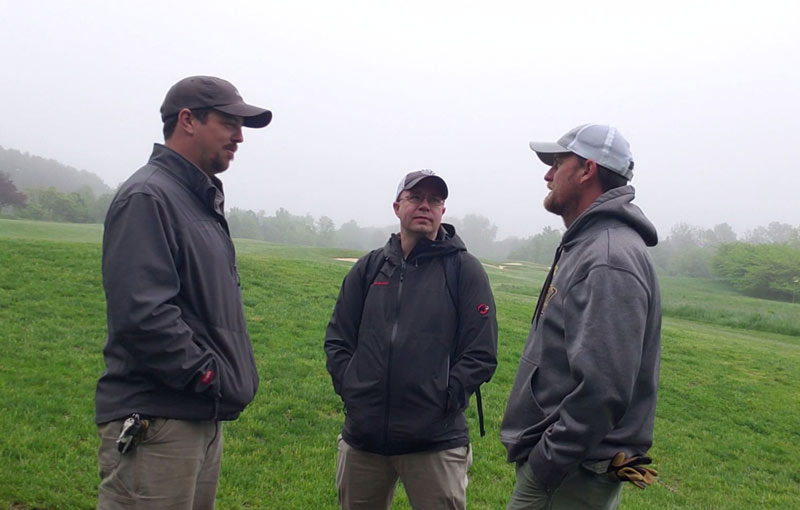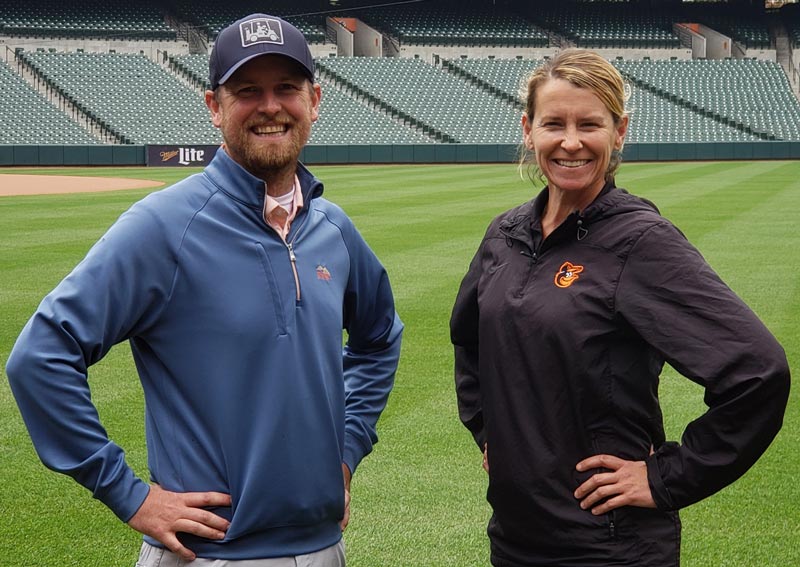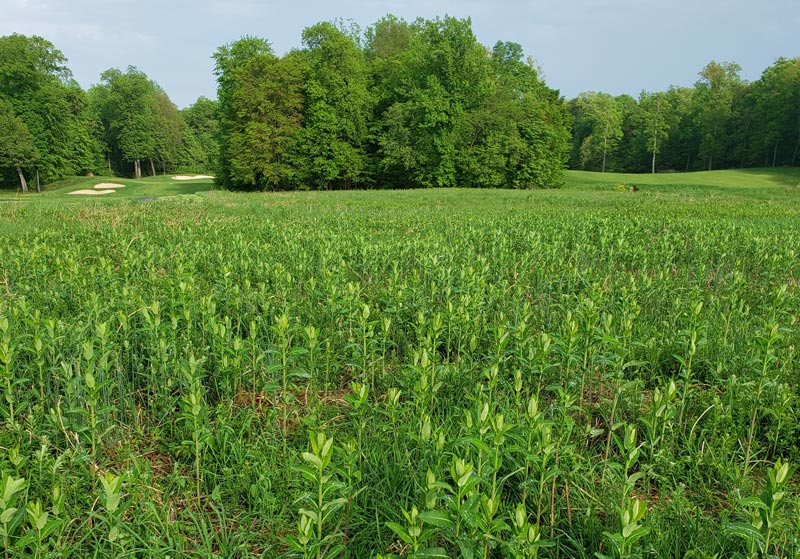
Sales representatives are among those who bridge the gap between the different sectors of turfgrass management. Here, author Logan Freeman, superintendent at Mountain Branch Golf Club in Joppa, Md., (right) and his assistant superintendent, Erik Dittmar (left), visit with Scott Orndorff, a sales representative from Landscape Supply Inc. Photos courtesy of Logan Freeman
While there is no debating that the turf industry has come under increased attacks from activist groups and one-sided legislation in the past few years, I believe there is a potentially dangerous gap in our defense.
Though not often talked about, a lack of cohesion among the different professions within turfgrass management has left us isolated and separated.
In the specific world of golf course management, we often discuss the importance of communication between the superintendent and golf shop staff, golfers, boards and committees. We also recognize the benefit of camaraderie and shared knowledge among golf course superintendents. Although the collaboration and community in golf is critical to the success of our work, the lack of communication and support across the various sectors of turfgrass management — golf, sports turf, home lawn care, university professionals, distributors, sales representatives — is rarely addressed.
The origin of this divide is difficult to pinpoint. Perhaps we superintendents felt that cultivating this long-term supportive relationship would have taken too much time and effort away from our immediate day-to-day operations. Or maybe we just saw no value in immersing ourselves in its complexities. Whatever the history, this disconnect now seriously undermines the future of our industry as a whole.
An eye-opening gathering
Like so many in our profession, I used to think that sports turf and lawn care just did their thing, and we as golf course turfgrass managers did ours. That’s the way it had always been and likely would remain. Then I went to a meeting for the formation of a local chapter of the Sports Turf Managers Association. This organic creation of the Mid-Atlantic STMA opened my eyes to an entirely different approach to my profession.
Of the hundred or so in attendance, I was the only golf course superintendent in the room. Yet instead of feeling alone and territorial, I felt a sense of connection and an appreciation for my presence. I also felt the support of what the people attending the meeting were trying to achieve.
I discovered a side of turfgrass management I had never before experienced, and I formed bonds with local sports turf managers I likely never would have met had I not attended as a sign of support for the new organization.

Forging relationships with fellow professionals in the various fields of turfgrass management — as Freeman (left) has with Nicole Sherry, head groundskeeper for the Baltimore Orioles — is a powerful piece of any effort to advance turfgrass managers’ collective interests.
Immediately following that meeting, I couldn’t stop wondering why the golf and sports sides of the industry were not more jointly associated. After all, we have far more commonalities than differences. We all manage turfgrass for its playability, in addition to juggling the management of people, budgets and the environment.
I also began to question why lawn care and other sectors were not a part of this supportive mix. If we are looking to move the turfgrass industry forward and address all the adversity facing us, we must come together in support and appreciation.
No matter our titles — golf course superintendent, head groundskeeper, lawn care provider, researcher, distributor — we all have a passion for this industry as well as a part to play in the narrative of its future.
The future of the turf industry
Our industry is increasingly challenged.
Part of this growing tension is positive, as ever-restrictive pesticide- and nutrient-management laws lead to innovation, ingenuity and leadership.
The downside, however, is equally present, as lawmakers who view the turfgrass industry as an easy target issue uninformed, blanket statements with little regard for repercussions. Their caustic words and changing tactics frequently appear as attacks aimed at our methods and the products we use rather than as honest attempts at finding common ground and viable solutions.
All too often, legislative bills are introduced at the last second to catch the turfgrass industry off guard. New legislation rarely comes directly on the national level; instead, legislation is brought forth at the county or township level. And while these restrictions are directed primarily toward a specific local aspect of turfgrass management — lawn care, sports turf, golf — the law is often expanded to other issues and geographical areas in subsequent years.
This is where a united industry front becomes critical, because legislation that comes uninformed and with destructive intent stands a greater chance of gaining a foothold and becoming commonplace if we remain an isolated and separated body. Now is the time for us to become unified and vigilant.
How golf course superintendents can be part of the solution
Each one of us must make the effort to reach out locally, regionally and statewide. Here are some next steps.
Locally
Find out who manages the sports fields in your area. Communicate with them and form a bond by helping each other. This also goes for lawn care providers, sod farmers and others who work with turfgrass in your community, as we are all potential partners.
Consider becoming involved in local outreach efforts such as the First Green program, which effectively shows our commitment to area youth and extends past golf into sports turf and lawn care. Engaging young people about the turfgrass industry can help educate away fears or misconceptions they and/or their families might have.
Proactively share with golfers, patrons, homeowners, legislators, educators and the general public the environmental benefits of golf course green space. Utilize programs such as Operation Pollinator and Monarchs in the Rough to help you get started in providing habitat to benefit even the smallest of creatures. Simply reducing or eliminating inputs between fairways and in out-of-play areas provides habitat for a whole range of ecology.

A field of milkweed — which is monarch butterfly-friendly — at Mountain Branch Golf Club in Maryland.
Sports field managers and lawn care providers can recommend pollinator-friendly flowers and reduced-input options. Planters outside a stadium and single landscape beds at a home are small actions, but they often lead to educational opportunities and serve as conversation starters.
Often, it seems people see our industries as a “silent spring,” adversely affecting the environment by constantly applying dangerous chemicals. The responsibility now falls on us to showcase our benefits and diversity of wildlife, and to educate those concerned.
Regionally
At the formation meeting of the Mid-Atlantic STMA, I noticed the one common thread among all turfgrass groups: sales representatives/distributors. To me, therefore, it seems obvious that regional sales reps and distributors serve as the primary conduit through which industry information is initiated and exchanged throughout all sectors. University and private researchers are additional common threads that can help the profession coalesce.
Chapter leaders should actively encourage joint functions among all the branches, whether the events are social or educational. Communication between different sectors and the leaders within them is crucial in the process. And if open lines of communication do not currently exist between the industry professionals in one’s area, an emphasis must be placed on improving and streamlining the exchange of information and mutual support.
Statewide
When legislation impacting our industry is misinformed or unnecessarily restricting, it is important that we take the time to educate our legislators regarding our products and their usage.
An established method of any proactive body is the development of best management practices (BMPs). The creation/implementation of BMP documents is already proving to be a powerful tool in the defense of our industry. When our practices are called into question, a BMP manual can provide evidence that we take our profession and its effects on the environment seriously.

Simply reducing inputs in out-of-play areas helps provide habitat for creatures big and small. By working together, diverse branches of the turfgrass industry can facilitate the adoption of such environmentally conscious initiatives throughout the profession as a whole.
We are proud that Maryland was the first state to complete its BMP turfgrass manual, and we’re beginning to discover its benefit during legislative sessions. The BMP document is a positive first step in unifying the turfgrass industry here in Maryland, and we applaud GCSAA for its effort to encourage all states to follow our lead.
Current and future challenges facing the turfgrass industry will require a multifaceted effort. Documentation like the BMPs, community outreach programs like First Green, and proactive communication with legislative officials, the public and all facets of the industry will serve vital roles in shaping the community’s understanding of our industry.
A unified front
Rather than standing silent, segmented and unengaged, we must work as a fully functioning alliance of turfgrass professionals in order to address today’s challenges effectively. We must personally reach out to the different sectors within our own turfgrass communities, for we will engage more willingly if we have a friend or close colleague being affected by new legislation. Chapters, associations and councils from around the industry must reach out to each other and work as a unified group.
For those of us in Maryland, the Maryland Turfgrass Council will serve as a catalyst for solidifying relationships among different turfgrass groups within the state, especially via events like joint turfgrass profession trade shows. National organizations such as GCSAA and STMA can help consolidate industry support through timely messaging via social and print media.
Proactive and courageous leadership will be paramount. The true strength of an industry comes down to the passion, engagement and vision of the individuals who underwrite it. It has been my experience that turfgrass management is full of hardworking, dedicated and driven people. I believe that, with the right balance of camaraderie and shared knowledge, our industry will adapt and thrive despite the challenges that lie ahead.
Logan Freeman is the GCSAA Class A superintendent at Mountain Branch Golf Club in Joppa, Md., and a 10-year association member.